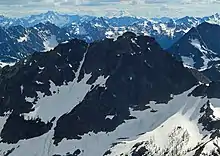| Copper Benchmark | |
|---|---|
 Copper Benchmark seen from Wallaby Peak | |
| Highest point | |
| Elevation | 7,840 ft (2,390 m)}[1] |
| Prominence | 1,169 ft (356 m)[1] |
| Isolation | 0.9 mi (1.4 km)[1] |
| Coordinates | 48°29′49″N 120°37′43″W / 48.49683°N 120.628499°W[1] |
| Geography | |
 Copper Benchmark  Copper Benchmark Copper Benchmark (the United States) | |
| Parent range | North Cascades |
| Topo map | USGS McAlester Mountain |
| Climbing | |
| Easiest route | Scrambling class 3 |
Copper Benchmark,[1] also known as Copper Point,[2] is a mountain summit located in the Methow Mountains, a sub-range of the North Cascades, on the shared border between Okanogan County and Chelan County in Washington state. Copper Benchmark is situated on the crest of the Cascade Range between Kangaroo Pass and Copper Pass. It was used as a triangulation station for early surveying.[2] It is protected by the Lake Chelan-Sawtooth Wilderness within the Okanogan–Wenatchee National Forest. Copper Benchmark has a subsidiary peak, Pica Peak (elevation 7,565 feet (2,306 m), which is 0.52 miles (0.84 km) northwest of the summit.[2][3] The nearest higher peak is Wallaby Peak, 0.9 miles (1.4 km) to the northeast.[1] Precipitation runoff on the north side of the mountain drains into the Methow River via Early Winters Creek, whereas the other sides of the mountain drain into tributaries of the Chelan River.
Climate
Copper Benchmark is located in the marine west coast climate zone of western North America.[2] Most weather fronts originate in the Pacific Ocean, and travel northeast toward the Cascade Mountains. As fronts approach the North Cascades, they are forced upward by the peaks of the Cascade Range (Orographic lift), causing them to drop their moisture in the form of rain or snowfall onto the Cascades. As a result, the west side of the North Cascades experiences high precipitation, especially during the winter months in the form of snowfall.[2] During winter months, weather is usually cloudy. However, due to high pressure systems over the Pacific Ocean that intensify during summer months, there is often little or no cloud cover during the summer.[4]
Geology
The North Cascades feature some of the most rugged topography in the Cascade Range with craggy peaks, ridges, and deep glacial valleys. Geological events occurring many years ago created the diverse topography and drastic elevation changes over the Cascade Range leading to the various climate differences.

The history of the formation of the Cascade Mountains dates back millions of years ago to the late Eocene Epoch.[5] With the North American Plate overriding the Pacific Plate, episodes of volcanic igneous activity persisted.[5] In addition, small fragments of the oceanic and continental lithosphere called terranes created the North Cascades about 50 million years ago.[5]
During the Pleistocene period dating back over two million years ago, glaciation advancing and retreating repeatedly scoured the landscape leaving deposits of rock debris.[5] The U-shaped cross section of the river valleys is a result of recent glaciation. Uplift and faulting in combination with glaciation have been the dominant processes which have created the tall peaks and deep valleys of the North Cascades area.

References
- 1 2 3 4 5 6 "Copper Benchmark". Peakbagger.com. Retrieved 2018-10-06.
- 1 2 3 4 5 Beckey, Fred W. (2009). Cascade Alpine Guide: climbing and high routes, Vol. 3, Rainy Pass to Fraser River (3rd ed.). Mountaineers Books. p. 302. ISBN 978-1-59485-136-0.
- ↑ "Pica Peak". Peakbagger.com. Retrieved 2018-10-06.
- ↑ Beckey, p. 16
- 1 2 3 4 Kruckeberg, Arthur (1991). The Natural History of Puget Sound Country. University of Washington Press.